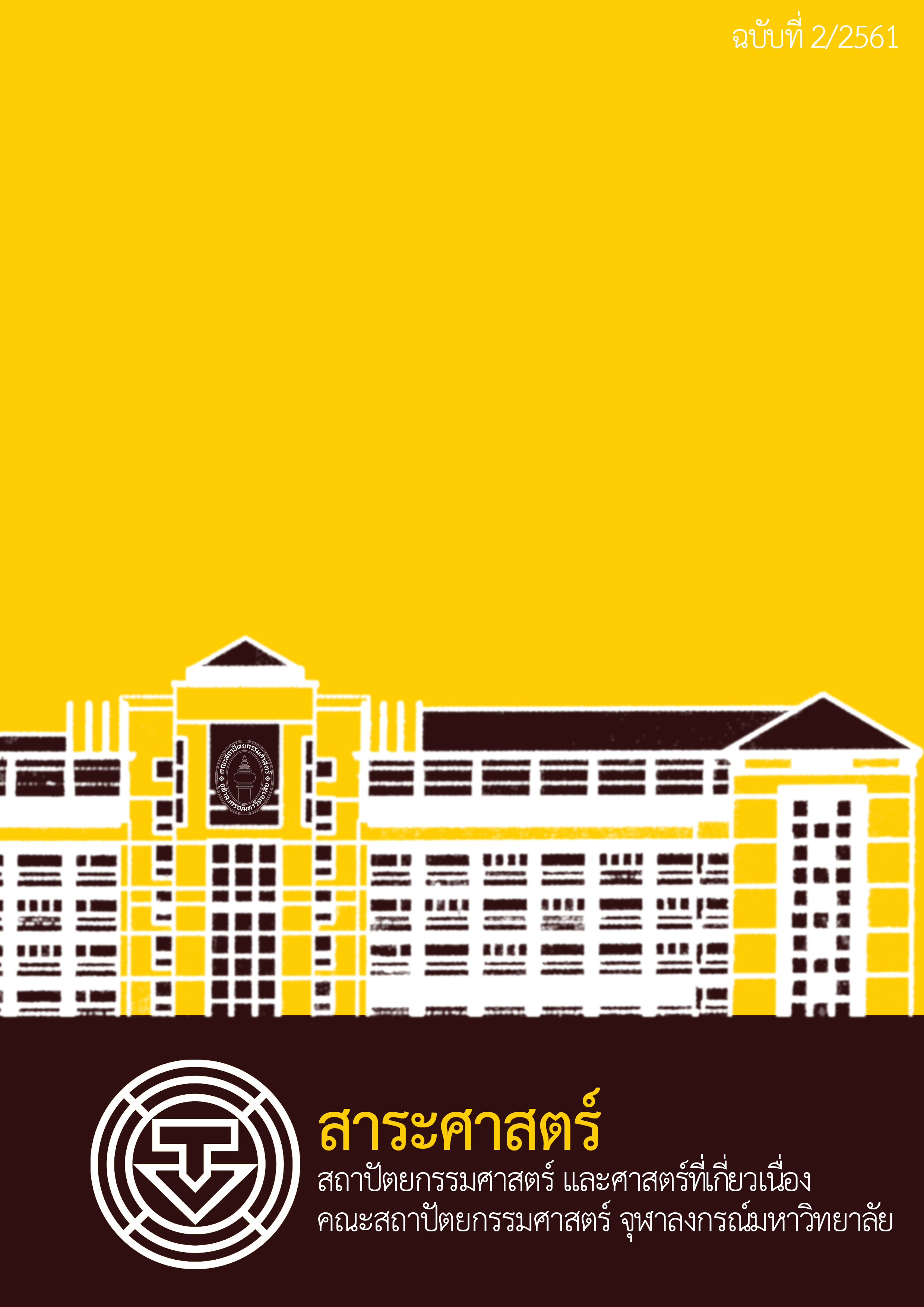การก่อสร้างด้วยบ้านชิ้นส่วนสำเร็จรูป : การประกอบติดตั้งชิ้นส่วนคอนกรีตสำเร็จรูป บ้านเดี่ยว
Main Article Content
บทคัดย่อ
วัตถุประสงค์เพื่อศึกษาการประกอบติดตั้งชิ้นส่วนคอนกรีตสำเร็จรูปในการก่อสร้างบ้าน โดยเลือกบ้านเดี่ยวของ
บริษัท ไลฟแอนด์ลีฟวิ่ง จำกัด และ ของบริษัท พฤกษา โฮลดิ้ง จำกัด (มหาชน) เป็นกรณีศึกษา
จากการศึกษาพบว่า การก่อสร้างบ้านเดี่ยวด้วยชิ้นส่วนสำเร็จรูป ของทั้งสองบริษัทมี 24 งานคล้ายกัน ตั้งแต่งาน
ตอกเสาเข็ม ไปจนถึงงานเทพื้นถนนคอนกรีต โดยสามารถแบ่งเป็น 65 งานย่อย ที่แตกต่างกันเล็กน้อย ส่วนการ
ประกอบติดตั้งชิ้นส่วนคอนกรีตสำเร็จรูป จะเริ่มดำเนินการหลังจากตอกเสาเข็มและหล่อฐานตอม่อแล้วเสร็จ โดยบริษัท
ไลฟแอนด์ลีฟวิ่ง จำกัด จะเริ่มติดตั้งแผ่นผนังชั้นล่างไว้บนเสาเข็มและฐานตอม่อก่อน ส่วนของบริษัท พฤกษา โฮลดิ้ง
จำกัด (มหาชน) จะหล่อพื้นคอนกรีตกับที่ก่อน แล้วจึงติดตั้งแผ่นผนังชั้นล่าง จากนั้นทั้งสองบริษัทจะเริ่มงานชั้นบน โดย
เริ่มจากติดตั้งชิ้นส่วนคานที่ต้องรับน้ำหนักผนังชั้นบน ในกรณีที่ติดตั้งไม่ตรงกับผนังชั้นล่าง ต่อมาจะติดตั้งแผ่นพื้นห้องน้ำ
และแผ่นพื้นชั้นบน แล้วจึงค่อยติดตั้งแผ่นผนังชั้นบน สำหรับงานพื้นชั้นล่าง ของบริษัท ไลฟแอนด์ลีฟวิ่ง จำกัด จะ
ดำเนินการหลังจากติดตั้งแผ่นผนังชั้นบนและเดินท่องานระบบใต้พื้นชั้นล่างแล้วเสร็จ โดยการหล่อหูช้างบริเวณฐานแผ่น
ผนังชั้นล่างก่อน แล้วจึงค่อยติดตั้งแผ่นพื้นชั้นล่าง
ด้วยวิธีการดังกล่าว พบว่าการหล่อพื้นคอนกรีตกับที่ ของบริษัท พฤกษา โฮลดิ้ง จำกัด (มหาชน) จะดำเนินการ
ได้ ต่อเมื่องานเดินท่องานระบบใต้พื้นแล้วเสร็จเสียก่อน ซึ่งมีความยุ่งยากและใช้เวลานาน ส่วนกรณีของบริษัท ไลฟ
แอนด์ลีฟวิ่ง จำกัด พบว่ามีรอยแตกร้าวบนแผ่นผนังชั้นล่าง ซึ่งปัจจุบันจึงได้เปลี่ยนมาใช้แผ่นผนังคอนกรีตอัดแรง แต่ก็ทำ
ให้มีค่าใช้จ่ายสูงขึ้น และการทำงานยุ่งยากมากขึนu รวมทั้งการหล่อหูช้างสำหรับวางแผ่นพื้นชั้นล่างซึ่งเป็นการเพิ่มงาน
และเพิ่มระยะเวลา
ทั้งสองบริษัทแม้จะมีวิธีการที่คล้ายกัน ต่างมีปัญหาเหมือนกันและต่างกัน เมื่อเปรียบเทียบวิธีการของทั้ง สองบริษัท และ
ปรับเปลี่ยนบางวิธีจะช่วยแก้บางปัญญาหาที่เกิดขึ้นได้ เช่น งานพื้น ชั้นล่าง ถ้าเพิ่มชิ้นส่วนคาน เพื่อรองรับแผ่นผนัง แทน
การติดตั้งผนังไว้บนเสาเข็มและฐานตอม่อ แม้จะเป็นการเพิ่มงาน แต่จะช่วยแก้ปัญหาแผ่นผนังแตกร้าวได้ โดยไม่ต้อง
ใช้แผ่นผนังคอนกรีตอัดแรง และสามารถลดงานพื้นคอนกรีตหล่อกับที่ และการหล่อหูช้างเพิ่มได้ ในส่วนงานพื้นชั้นบน ให้
ยกเลิกการติดตั้งชิ้นส่วนคาน โดยเปลี่ยนแผ่นผนังที่เคยมีชิ้นส่วนคานรองรับ เป็นแผ่นผนังคอนกรีตอัดแรงมาแทน
Article Details
เอกสารอ้างอิง
ชาคริต ทีปกรสุขเกษม, กรรมการผู้จัดการ บริษัท ซีแพนเนล จำกัด, ผู้สัมภาษณ์ : iBiz, 30 ตุลาคม 2557, [Online]
https://www.manager.co.th/iBizChannel/ViewNews.aspx?NewsID=9570000125114 (15 ตุลาคม 2560).
บัณฑิต จุลาสัย, “ระบบชิ้นส่วนสำเร็จรูป,” อบรมโครงการจุฬานำความรู้สู่สังคม จ.เชียงใหม่, (กุมภาพันธ์ 2561).
สมปอง สง่าแสง, “คอนกรีตเสริมเหล็กและทฤษฎีหน่วยแรงใช้งาน,” ตำรา-เอกสาร ฉบับที่ 43, (วศ.บ.(จุลาฯ), ภาคพัฒนาตำราและเอกสารวิชาการหน่วยศึกษานิเทศก์, 2534).
อรุณ ชัยเสรี, เกร็ดความรู้เกี่ยวกับการควบคุมงานก่อสร้างอาคารคอนกรีตเสริมเหล็ก. แก้ไขปรับปรุงครั้งที่ 4 พิมพ์ครั้งที่ 7, (วิศวกรรมสถานแห่งประเทศไทย ในพระบรมราชูปถัมภ์, พฤษภาคม 2556).
ชัชวาล เศรษฐบุตร, “คอนกรีตเทคโนโลยี (Concrete Technology)”.
นรินทร์ พุทธอารักษ์วงศ์, “การเปรียบเทียบการก่อสร้างบ้านเดี่ยว 2 ชั้น ด้วยชิ้นส่วนสำเร็จรูป เสา-คาน กับการก่อสร้าง ระบบเดิม,”(วิทยานิพนธ์ปริญญามหาบัณฑิต, ภาควิชาเคหการ คณะสถาปัตยกรรมศาสตร์ จุฬาลงกรณ์มหาวิทยาลัย, 2549).
ปรวิทย์ หิมาตวิน, “การเปรียบเทียบรอยต่อระบบแห้งและระบบเปียกของระบบโครงสร้างคอนกรีตเสริมเหล็กสำเร็จรูป,” (วิทยานิพนธ์ปริญญามหาบัณฑิต, ภาควิชาสถาปัตยกรรมศาสตร์ คณะสถาปัตยกรรมศาสตร์ จุฬาลงกรณ์มหาวิทยาลัย, 2549).
รณกร ชมธัญกาญจน์, “กระบวนการก่อสร้างด้วยชิ้นส่วนสำเร็จรูป ประเภทบ้านเดี่ยวกรณีศึกษา:บริษัท พฤกษา เรียลเอสเตท จำกัด (มหาชน),” (วิทยานิพนธ์ปริญญามหาบัณฑิต, ภาควิชาสถาปัตยกรรม คณะสถาปัตยกรรมศาสตร์ จุฬาลงกรณ์มหาวิทยาลัย, 2555).
วิกรม เหล่าวิสุทธิชัย, “การเปรียบเทียบกระบวนการผลิตชิ้นส่วนคอนกรีตสำเร็จรูปในที่ตั้งโครงการและในโรงงาน กรณีศึกษา:โครงการหมู่บ้านแฟมิลี่ ซิตี้ บริษัท ไลฟ แอนด์ ลีฟวิ่ง จำกัด จ.ชลบุรี และโรงงานผลิตชิ้นส่วนคอนกรีตสำเร็จรูปที่ 6 บริษัทพฤกษา เรียลเอสเตท จำกัด (มหาชน),” (วิทยานิพนธ์ปริญญามหาบัณฑิต, ภาควิชาสถาปัตยกรรมศาสตร์ คณะสถาปัตยกรรมศาสตร์ จุฬาลงกรณ์มหาวิทยาลัย, 2560).


